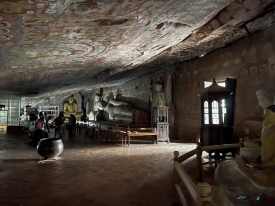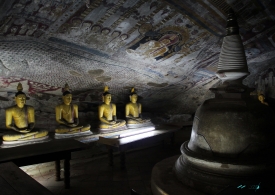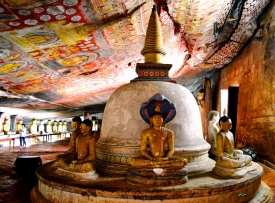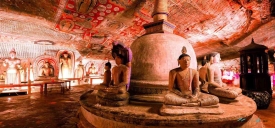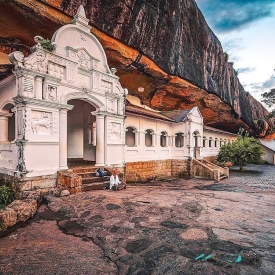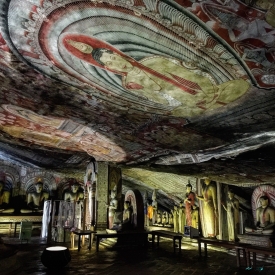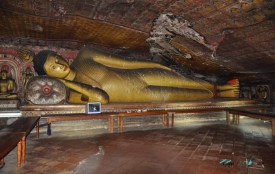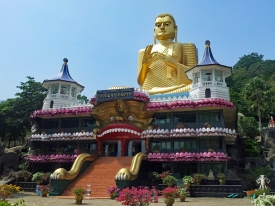The Dambulla Cave Temple's origins are steeped in legend and historical significance. Its history is a vivid tapestry of royal patronage, religious devotion, and artistic expression spanning over two millennia.
The Dambulla Cave Temple continues to function as a monastery, preserving its sacred traditions. It stands as a symbol of Sri Lanka's enduring spiritual heritage and artistic prowess. The temple's serene setting, with panoramic views of the surrounding landscape, including the iconic Sigiriya Rock Fortress, adds to its allure.
The caves of Dambulla are believed to have been inhabited as far back as the prehistoric era. Archaeological evidence suggests that prehistoric Sri Lankans found shelter in these caves long before the advent of Buddhism on the island. The discovery of human burial sites dating back around 2,700 years near the temple complex at Ibbankatuwa underscores the area's ancient human presence.
The transformation of these natural caves into a Buddhist monastic complex is attributed to King Valagamba of Anuradhapura, also known as Vattagamani Abhaya. During his tumultuous reign in the 1st century BCE, the king was forced into exile following an invasion from South India. The caves of Dambulla provided him sanctuary during this period of upheaval. Upon regaining his throne, King Valagamba expressed his gratitude by converting the caves into a Buddhist temple, laying the foundation for what would become one of the most revered religious sites in Sri Lanka.
Over the centuries, the Dambulla Cave Temple saw significant enhancements and expansions under various monarchs. In the 12th century, King Nissanka Malla of Polonnaruwa made substantial contributions by gilding 50 statues of the Buddha, earning the cave the name "Cave of the Great Kings" (Maharaja Lena). This period marked the beginning of the temple's golden age, with many kings following suit and enriching the temple with art and architecture.
The 18th century witnessed a revival of the temple under the Kandyan Kingdom. King Kirti Sri Rajasinha, a prominent Buddhist revivalist, commissioned the renovation of the caves, adding intricate paintings in the Kandy style and further statues to the collection. This era saw the temple solidifying its status as a major center of Buddhist worship and art.
More than 80 caves have been recorded so far, which has about 153 Buddha statues and exquisite murals covering an area of 2,100 square meters in and around the temple. It is the largest group of murals in South Asia and one of the oldest. ancient paintings on earth. There are a total of 5 grottoes open to the public.
The Dambulla temple complex consists of five caves of varying sizes and magnificence. These caves, built at the base of a towering 150-meter-high rock during the Anuradhapura (1st century BC to 993 AD) and Polonnaruwa (1073 to 1250) periods, are undoubtedly the most impressive among the many cave temples found in Sri Lanka. Access is via a gentle slope on the Dambulla Rock, offering a panoramic view of the surrounding plains, including the rock fortress of Sigiriya, located 19 km away. As dusk falls, hundreds of swallows swoop around the cave entrance. The largest cave measures approximately 52 meters from east to west and 23 meters from the entrance to the back, reaching a height of 7 meters at its highest point. Inside these caves, not only are Hindu deities represented, but also kings Valagamba and Nissankamalla, as well as Ananda, the Buddha's most devoted disciple. As a tourist, I am absolutely fascinated by the majesty and history that envelop these ancient caves.
In modern times, the Dambulla Cave Temple has been recognized for its historical and cultural value. Its designation as a UNESCO World Heritage Site in 1991 highlights its significance as an outstanding example of Sri Lankan religious and artistic tradition. Efforts to preserve the temple's delicate frescoes and statues continue, ensuring that this ancient monument remains a vibrant testament to the island's rich heritage.
The Dambulla Cave Temple continues to function as a monastery, preserving its sacred traditions. It stands as a symbol of Sri Lanka's enduring spiritual heritage and artistic prowess. The temple's serene setting, with panoramic views of the surrounding landscape, including the iconic Sigiriya Rock Fortress, adds to its allure.
Early Beginnings and Royal Refuge
The caves of Dambulla are believed to have been inhabited as far back as the prehistoric era. Archaeological evidence suggests that prehistoric Sri Lankans found shelter in these caves long before the advent of Buddhism on the island. The discovery of human burial sites dating back around 2,700 years near the temple complex at Ibbankatuwa underscores the area's ancient human presence.
The transformation of these natural caves into a Buddhist monastic complex is attributed to King Valagamba of Anuradhapura, also known as Vattagamani Abhaya. During his tumultuous reign in the 1st century BCE, the king was forced into exile following an invasion from South India. The caves of Dambulla provided him sanctuary during this period of upheaval. Upon regaining his throne, King Valagamba expressed his gratitude by converting the caves into a Buddhist temple, laying the foundation for what would become one of the most revered religious sites in Sri Lanka.
A Flourishing Center of Worship
Over the centuries, the Dambulla Cave Temple saw significant enhancements and expansions under various monarchs. In the 12th century, King Nissanka Malla of Polonnaruwa made substantial contributions by gilding 50 statues of the Buddha, earning the cave the name "Cave of the Great Kings" (Maharaja Lena). This period marked the beginning of the temple's golden age, with many kings following suit and enriching the temple with art and architecture.
The 18th century witnessed a revival of the temple under the Kandyan Kingdom. King Kirti Sri Rajasinha, a prominent Buddhist revivalist, commissioned the renovation of the caves, adding intricate paintings in the Kandy style and further statues to the collection. This era saw the temple solidifying its status as a major center of Buddhist worship and art.
The caves
More than 80 caves have been recorded so far, which has about 153 Buddha statues and exquisite murals covering an area of 2,100 square meters in and around the temple. It is the largest group of murals in South Asia and one of the oldest. ancient paintings on earth. There are a total of 5 grottoes open to the public.
The Dambulla temple complex consists of five caves of varying sizes and magnificence. These caves, built at the base of a towering 150-meter-high rock during the Anuradhapura (1st century BC to 993 AD) and Polonnaruwa (1073 to 1250) periods, are undoubtedly the most impressive among the many cave temples found in Sri Lanka. Access is via a gentle slope on the Dambulla Rock, offering a panoramic view of the surrounding plains, including the rock fortress of Sigiriya, located 19 km away. As dusk falls, hundreds of swallows swoop around the cave entrance. The largest cave measures approximately 52 meters from east to west and 23 meters from the entrance to the back, reaching a height of 7 meters at its highest point. Inside these caves, not only are Hindu deities represented, but also kings Valagamba and Nissankamalla, as well as Ananda, the Buddha's most devoted disciple. As a tourist, I am absolutely fascinated by the majesty and history that envelop these ancient caves.
In modern times, the Dambulla Cave Temple has been recognized for its historical and cultural value. Its designation as a UNESCO World Heritage Site in 1991 highlights its significance as an outstanding example of Sri Lankan religious and artistic tradition. Efforts to preserve the temple's delicate frescoes and statues continue, ensuring that this ancient monument remains a vibrant testament to the island's rich heritage.



